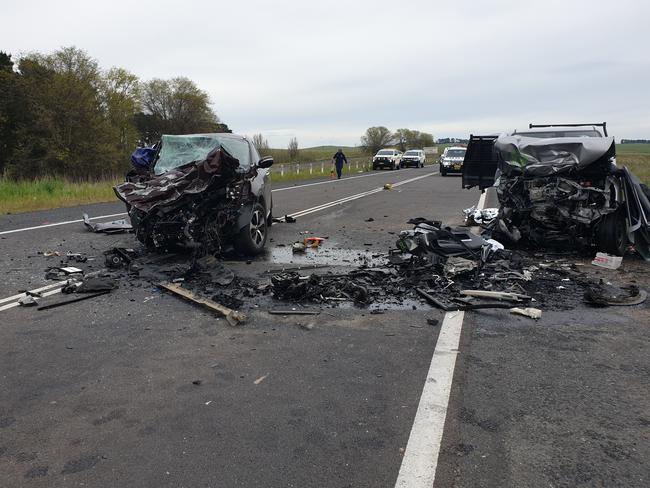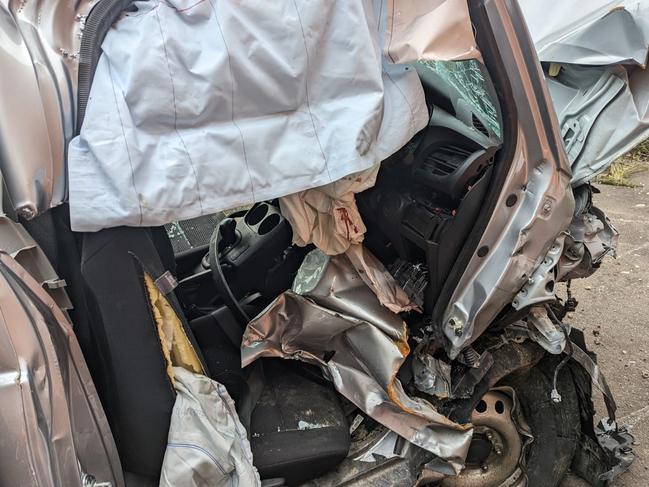‘My ute’s smart airbag saved my life’
Nathan Steenbergen remembers the moment of impact, the crushing sound of metal and the pain through his whole body after being in a crash which killed the other driver. Then help arrived.
Police & Courts
Don't miss out on the headlines from Police & Courts. Followed categories will be added to My News.
Exclusive: Nathan Steenbergen remembers the moment of impact, the crushing sound of metal, the pain through his whole body and the activation of his airbags after a car crossed onto the wrong side of the Barton Highway and collided head-on with his ute.
Then he remembers a voice projecting from his mangled dashboard: “You’ve been in an accident on the Barton Highway, emergency services are on their way.”
His vehicle was fitted with a safety feature known as “e-call” that automatically contacted triple-0 with his location near Yass and information he had been in a crash when the airbags deployed — and it saved his life.
Falling in and out of consciousness and unable to move, Mr Steenbergen was trapped in the wreck of his Toyota HiLux, with severe injuries to most of his body.
His aorta was torn, his ankle smashed into pieces, his nose broken as well as his collarbone and his bowel was seriously damaged.

But due to the airbag technology, police and paramedics responded almost immediately, arriving at the scene in less than 25 minutes.
Any longer, and police say Mr Steenburgen – a young father – may not have made it.
Sergeant Stephen Pidgeon was on his way to work when he heard the sirens and changed route, arriving to find a scene of carnage. Mr Steenbergen was trapped, and the man who collided with him had died on impact.
“I thought we were arriving to find people had died in both cars,” Sergeant Pidgeon said.


“I was very surprised when they said Nathan had survived … the technology I think was really vital to that.”
Mr Steenbergen spent nine weeks in hospital and underwent multiple surgeries, faced with the prospect he may not be able to walk again.
But after a long rehabilitation journey he is back on his feet, and making the most of everyday with his young son Toby and wife Carmel – crediting the e-call technology for his second chance at life.
“With the injuries I had, it could have been a very different story,” he said.
“The paramedics and police knew about the crash within minutes and I think that changed my life.
“I’ve got a lot more time with my family now.”

According to Transport for NSW Chief of the Centre for Road Safety Bernard Carlon, the e-call technology not only saves lives, but has the potential to reduce the impact of long-term injuries.
In Europe, all new car models are mandated to have an in-built e-call system, a standard he hopes to see in Australia.

“It’s been appearing in our cars since 2018, but we want to see it become the norm,” he said.
“Seventy per cent of our fatal crashes are happening on country roads, and many of them in isolated locations, so the time of getting emergency services to them is critical.
“Like in Nathan’s case, it’s particularly important if someone is unconscious or severely injured.”
The e-call system has its own battery and speaker, designed not to break or malfunction during a collision.
Starting with the mandatory wearing of seatbelts in 1971, new technology and safety features on cars such as mandatory airbags and lane keep assist, along with regulations, enforcement strategies and better roads, have had a dramatic impact on the road toll.
The road toll peaked in the 70s at more than 1300 for NSW, falling to 351 by 2023.
As National Road Safety Week ends, both Mr Steenbergen and Mr Carlon have urged people to look into the safety ratings of their vehicles, and make an informed decision before buying.
“It could mean your life,” Mr Steenbergen said.
Got a news tip? Email weekendtele@news.com.au





